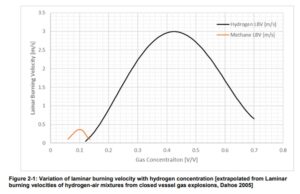



The Rhino HySafe Vertexc range of explosion relief panels have been specifically designed for venting hydrogen/air explosions and explosions involving other more reactive flammable gases.
This is a challenging application as hydrogen/air explosions are characterised by very rapid rates of pressure rise compared to gas explosions involving natural gas. Hydrogen has a wide flammable range and high laminar burning velocity. Figure 2-1 shows the variation of laminar burning velocity of hydrogen with concentration at ambient temperature and pressure. The laminar burning velocity of methane is also shown (majority component of natural gas). The graph indicates that a hydrogen explosion will develop very quickly compared to natural gas deflagrations.

To successfully vent a hydrogen explosion, relief panels must be capable of reacting to pressure increase very quickly. A panel should be capable of activating at a low overpressure and open rapidly. It is sensible to choose a lightweight panel because heavy panel would move slowly. If the vent space does not open fast enough, failure of the structure being protected can occur. Beyond a design that allows quick response, a panel should not disintegrate (safety), activate falsely under extreme weather conditions (useability and weather), or allow an easy access point for nuisance entry (security).
Rhino HySafe explored this problem with the help of leading industry specialists. The optimal solution was found to be thin stainless steel ‘doors’ of size and thickness that allow them to respond quickly, attached to a frame that is robust with intruder-resistant bars across the openings. The combination of door materials, fixings and the latch allow quick opening at low explosion overpressures whilst preventing false-opening from wind and/or other sources.
To demonstrate the efficacy of the panels, Rhino HySafe approached DNV Spadeadam for testing services and Lloyds Register to act as an independent witness. The approach taken was to partially fill a 26 m3 chamber with a hydrogen-gas mixture that is recirculated to generate a volume of uniform concentration. By varying the concentration it was possible to produce explosions of differing severity. The volume of the explosion chamber is about 80% of the volume of a 20 ft ‘ISO’ shipping container (volume of 33 m3 ). Thus, the experimental arrangement is comparable to a 20 ft ISO shipping container volume with equipment or items occupying part of its volume.
The confining walls of the explosion chamber were irregular. This causes the flame to accelerate and thus make the explosions more severe than a smooth walled chamber. The vent was away from the hydrogen/air filled volume meaning that the explosion pushed cold non-ignitable air ahead of it before explosion venting occurred. Partially-filling the volume of the explosion chamber with a uniform hydrogen-air mixture was useful experimentally in that it limits the peak overpressures generated. This allowed the use of higher (more reactive) hydrogen concentrations which produce higher rates of pressure rise. Conceptually, using a partial-volume-fill volume also had relevance to real-world accident scenarios where it is credible that (i) the release is transient, leading to (ii) a localised non-uniform concentration of hydrogen that (iii) ignites immediately and (iv) is far from the venting area.
In all tested cases, the vent panels activated, allowing safe venting of the explosion products. Measured pressures in the vent were up to 850 mbar and rates of pressure rise above 30 bar/s were measured. Those conditions are severe structurally and would be very difficult to replicate in any test work using less reactive hydrocarbon fuels to drive the explosion.
During the dynamic test phase no hazardous fragmentations were produced at overpressures of 644 mbar, with a rate of pressure rise of 17.4 bar/s which is well beyond the performance envelope of any real-world applications.